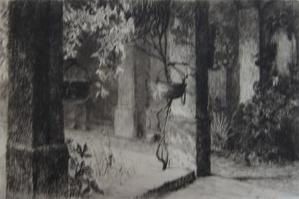
The etchings of Maurice Achener by Louis Seyden
In all epochs artists have seen to suddenly find themselves after having long and laboriously searched for their way. Such was not the case with Maurice Achener, however.
He had etched some twenty years and if he worked much, with the feelings always, sometimes a little uncertainly, from the very first his work has shown the impress of sincerity. One can go through it from the first to the last plate without finding the least suspicion of the deliberate use of any artifice. The desire to strike the imagination is totally foreign to him, and no etcher is less literary in the sense that is given to this qualification today. Let us understand by this that in a landscape whether in his native Alsace, in Italy, or in the Isle of France, disregarding theory and recollections, he has only he has only the desire to be an analyst of as great penetration as possible. Blank perhaps to the uncultivated or superficial observer, because often less pictures than their reflection his works enchants the delicate by shades of intense expression, by its refined sensitiveness which is left to ones divination.
One may well understand that’s Achener’s success under such conditions have been slow and progressive. He had from the first followers on whom the quality of his esprit and of is work was not lost. A circle of faithful collectors, growing larger every year, followed and encouraged him, classing him among contemporary etchers of solid reputation, and the future will certainly rank him among the masters.
Born in 1881 at Mulhouse, Achener studied at first in his own country, then at Munich. He destined himself to paintings, which he never gave up completely; his sending to the Société Nationale des Beaux Arts while not frequent have not passed unnoticed "sic". But soon, perhaps under the influence of one of his professors at Munich, P.Halm, himself etcher of repute, he began to feel the attraction of the point and the etching. But he did not give himself up to it definitely until after he had tried the wood block.

About 1909, sollicited by an amateur, M Spetz to illustrate a collection of legendary poems, he acquired by himself the technique of the wood block, and even his first effort were successful. We may add in passing that he returned to the wood engraving in 1919, illustrating La princesse Maleine, of Maurice Maeterlinck, and in1922 making the very important illustrations for La faute de l’abbé Mouret by Emile Zola.

But it is with the etching; that we are concerned here. His first plate date from 1902. The subject he chose from the country round around him, at Strasbourg and vicinity, attacking the most diverse themes, landscape, architecture, interiors. He even etched figure subjects a Dutch woman, a fisherman, some portraits. His character being (idealism and talent apart) laborious and conscientious, these first effort although scattered are yet not without value. The struggle of the artist with the technique of the medium which must to be learned is not too evident, and if the techniques hesitate at times, the vision is already personal. Before commencing to etch he had made many designs and painting which one readily perceives even in his first efforts. When he started to works with the needle he had therefore long been in the possession of the requisite knowledge acquired as a painter, of what subject to choose and how to translate it. It is without doubt to this that these first are a quality often lacking in the early work, the result of experience, thought and happy simplifications…..




